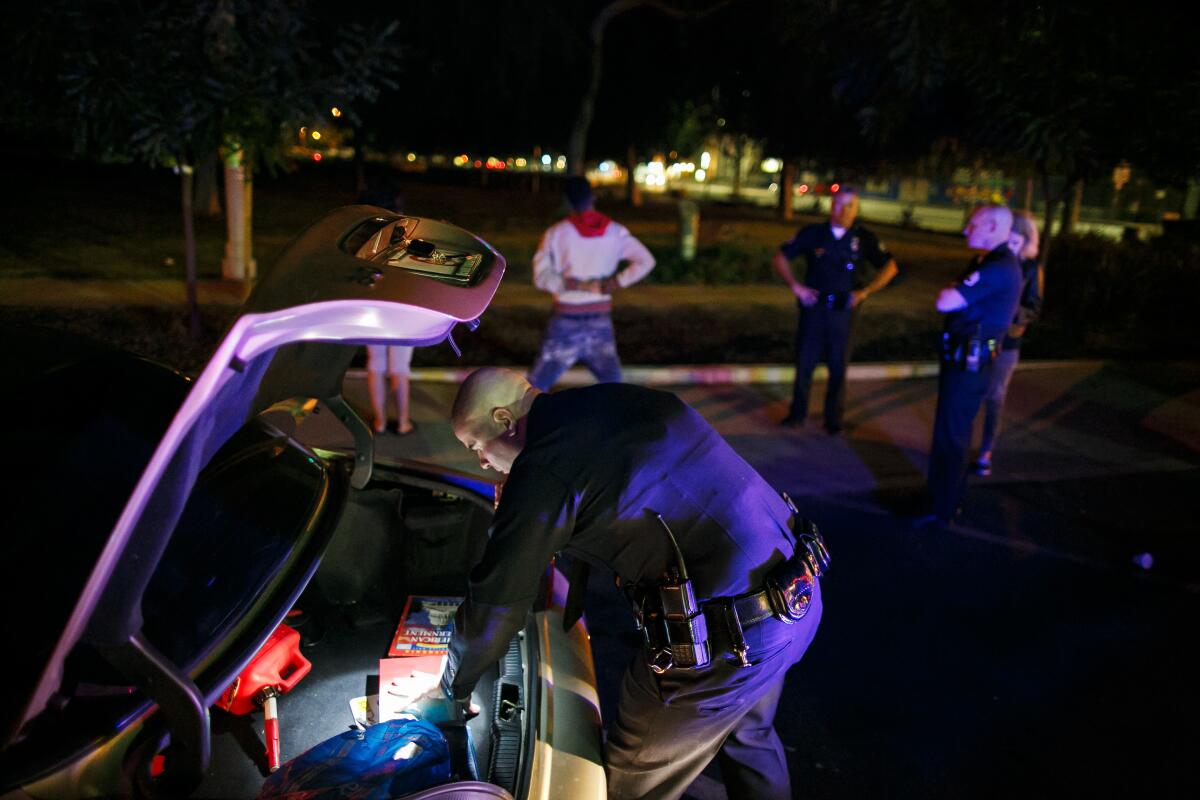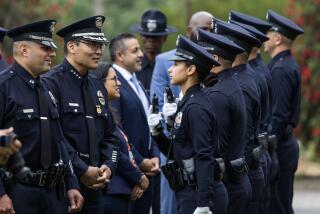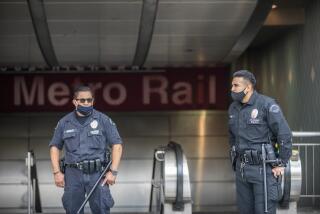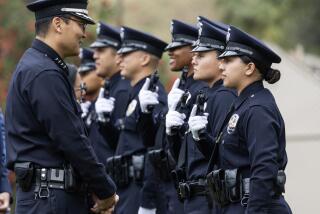How can L.A. stop traffic deaths? Let civilians enforce traffic violations, study says

- Share via
Most traffic enforcement in Los Angeles should be done by civilian workers, but only in tandem with major infrastructure upgrades that improve safety along city streets that are among the nation’s deadliest.
Those are the conclusions of a long-delayed report from the city transportation department that has yet to be released. The Times reviewed a draft of the document, which is being produced by an outside firm and has been in the works for nearly three years, since the City Council first raised the prospect of removing traffic duties from the Los Angeles Police Department.
The debate over what role police should have in enforcing traffic safety comes amid an alarming yearlong rise in road deaths and injuries. It illustrates both the promise and the challenge of removing armed officers from traffic safety duties.
Some transportation safety advocates say persistent traffic violence, particularly in low-income neighborhoods, shows that the city needs to crack down harder on reckless driving.
Supporters of criminal justice reform argue for a less punitive approach. They say those communities have historically borne the brunt of over-aggressive policing, which they contend hasn’t made the streets any safer.
And they allege that, even when such encounters don’t end in violence, the fines that often result can send people into spiraling debt.
Among the recommendations put forth by the city report is investing in so-called “self-enforcing infrastructure,” such as narrower streets, dedicated bike lanes and more clearly marked pedestrian crosswalks.
Such measures naturally slow the flow of traffic and discourage drivers from speeding or breaking other road laws. Much like the Vision Zero initiative — unveiled in 2015 by then-Mayor Eric Garcetti to end traffic deaths within a decade — they would increase safety and reduce the need for active enforcement in “high-injury network corridors, low-income communities, and communities of color,” the report said.
While the city could build on the existing Vision Zero model, the report said, it should be less reliant on law enforcement.
The city could, for example, use unarmed civilians to enforce “safety-related traffic violations” such as speeding, in the same vein as cities such as Berkeley, Oakland and Philadelphia, the report recommends.
At the same time, the city should consider “means-based” fee models — such as vouchers to repair broken taillights — for traffic violators, measures that “advance traffic safety objectives and do not perpetuate enforcement disparities.”
From the chronic problem of people running stop signs to a rise in sideshows that occasionally lead to injuries — such as street takeovers or drag racing — the work group found that the “aggressiveness of drivers towards nondrivers, including the unhoused, is a growing problem in Los Angeles.”
Headlines describing road violence involving pedestrians, bicyclists and motorists have piled up in recent months, including one case last month in which police say a possibly impaired driver barreled into a mother and her 6-year-old daughter as they walked to school in Mid-Wilshire. The mother was killed and the girl was critically injured.
According to Los Angeles Police Department data, 312 people were killed in traffic collisions in 2022, a 5% increase over the previous year and a 29% increase over 2020.
The city’s streets remain particularly deadly for pedestrians and bicyclists, with 159 people killed in collisions involving pedestrians and motorists last year. This is a 19% rise compared with 2021, LAPD data show. An additional 20 people died in collisions involving bicyclists and motorists, an 11% rise.
The traffic carnage outpaced national trends.
Even among the most ardent transportation advocates, reducing those numbers in a city as car-dependent as Los Angeles seems like an impossibly tall task.
“As a city, we get an F grade for our traffic, for the amount of traffic violations and our ability to curb serious fatalities and injuries,” said Damian Kevitt, executive director of Streets Are For Everyone. “I understand that we’ve got a housing crisis, I don’t disagree that we’re prioritizing that. But we [also] have a public health traffic violence crisis.”
Local officials, he said, need to find an approach to traffic safety that doesn’t repeat the harm of past efforts.
“The truth is, I don’t think anyone has a definite answer of what is that sweet spot; how do we balance that? Because it’s not equitable to have people dying on the streets of Los Angeles,” he said, adding that pedestrians of color are at higher risk of being run over “because they’re the ones who are walking the most or biking the most because they can’t afford a car.”
Experts say speed is a major factor in many serious crashes, and so reducing it can lead to fewer traffic deaths.
Jessica Hutton, an engineer with the Kansas City, Mo., firm Burns & McDonnell, said most drivers decide how fast to drive based on unconscious cues from a road’s design and surroundings. Thus, some cities can employ “a little bit of psychology” by designing “self-enforcing” roads that regulate speeds through changes, for example, to the width of a roadway or shoulder or the creation of more intersections.
The debate over the role of law enforcement in traffic incidents stretches back decades but intensified in the wake of George Floyd’s murder in 2020 at the hands of police officers in Minneapolis and the ensuing nationwide reckoning in which critics challenged some long-held assumptions around policing.
The draft report calls for further expanding the LAPD’s restrictions on so-called pretextual stops — using minor traffic violations as a reason to pull over vehicles and search them for evidence of more serious crimes. Such stops were already drastically scaled back after a Times investigation found that the department stopped and searched Black and Latino drivers at higher rates than white motorists.
Department officials have admitted these stops netted few arrests and undermined public trust.
Still, police officials around the U.S. have been slow to rein in the practice too much, saying that it is still a tool for getting guns and drugs off the streets.
LAPD officials have said they would be willing to relinquish certain traffic duties if they are picked up by another agency. But enforcement remains a top priority, they say, citing among other reasons the inherent dangers of traffic stops and a recent rise in accidents.
LAPD Chief Michel Moore said that “finding alternatives to a police response [to certain incidents] is something that the department is very much interested in.”
“If DOT [Los Angeles Department of Transportation] were to pick that work up, I think we’d welcome it,” he said.
He pointed out that teams of mental health workers already respond to some calls involving people in crisis, without police present, and that officers no longer “take traffic collision reports for anything other than the most serious traffic accidents.”
At the same time, he added, any changes must be weighed against “safety risk issues” posed in certain traffic encounters
Selling the proposed changes to the Los Angeles Police Protective League is another matter. Certain changes may have to be negotiated through collective bargaining, the report points out. And while the League, which is in contract talks with city leaders, has signaled its willingness to stop sending officers to certain low-level enforcement tasks, traffic duty is not one of them.
Even if Los Angeles wanted to put traffic enforcement into the hands of civilians, the assumption is that under the state vehicle code, such duties could only be handled by licensed peace officers. But the report argues that there are “plausible legal arguments that the vehicle code does not limit the City’s discretion in this area.”
The city Traffic Department already employs civilian “traffic officers,” who direct traffic and enforce parking restrictions, according to the report. While they are not technically peace officers, they have the authority to issue parking tickets and to “perform other related duties.”
Among those responsibilities is arresting “individuals without a warrant for a limited but varying list of civil violations related to taxis and ride-shares and other violations related to streets and sidewalks such as causing obstructions or dumping of prohibited substances,” according to the report.
LADOT did not immediately respond to requests for comment. The department has said the pandemic has worsened its staffing issues. Connie Llanos, the agency’s interim general manager, said during a recent budget presentation that her agency has 68 traffic officer vacancies. LADOT is also seeking new funding to expand its speed bump program to more locations around the city, including near schools.
Any next steps would probably require state legislative action, the report said. Policymakers would also need to get buy-in from communities that were “disproportionately burdened” by “high fees and privacy issues” and by past attempts at automated traffic enforcement, such as Los Angeles’ defunct and controversial red-light camera traffic enforcement program.
The report’s authors looked to models in other cities that, instead of deploying armed police, have tackled traffic safety by reinvesting in street improvements and educating the public while exploring alternative methods for holding motorists accountable.
Berkeley, for instance, has been developing a new division that aims to send unarmed representatives to certain traffic incidents, instead of police, as the city works toward its goal of reducing racial disparities in traffic stops and ending serious crashes by 2028.
In Philadelphia, officials voted to adopt a model of enforcement used in New Zealand, in which minor traffic violations are handled by unarmed public safety “officers” who work for that city’s transportation department.
More to Read
Sign up for Essential California
The most important California stories and recommendations in your inbox every morning.
You may occasionally receive promotional content from the Los Angeles Times.










